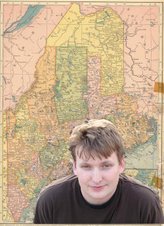Abel Janszoon Tasman was born in the village of Lutjegast, in today's province of Groningen in the Netherlands, in 1603. Little is known of Tasman's early life, and no portraits of him exist.
In 1632 he married Jannetje Tjaerts. He was already a widower at the time, and was recorded as being an ordinary sailor - "vaerentgesel" - and that he lived in a street in Amsterdam called Teerketelsteeg.
In 1633 Tasman signed up with the Dutch East India Company (Verenigde Oostindische Compagnie or VOC). The East India Company was managed by a board of seventeen - "de Heeren XVII" - the Lords Seventeen - and was appointed by Chambers in the principal trading towns. Eight Chambers were situated in Amsterdam, and four Chambers were in Zealand, a maritime province of the Netherlands.
On signing up with the Company, Tasman left for the East to fulfil a three year contract.
In 1638, he left the Netherlands for Batavia, (today's Djakarta, Indonesia) in command of the ship "Engel", this time on a ten year contract. His wife accompanied him. Batavia had grown to be a rich city, and here, from this good vantage point in the East Indies, the East India Company was successful and powerful - not lacking in wealth, men or ships.
On 13th August 1642 Tasman received instructions to find the mysterious and supposedly rich Southern Continent, which had been eluding and tempting explorers for centuries. This unknown land, Terra Australis Incognita, was said to stretch across the Pacific. Tasman's instructions were to take possession of all continents and islands discovered and set foot on in the course of his voyage "on behalf of their High Mightinesses the States-General of the United Provinces".
Two ships were prepared for the voyage : the "Zeehaen", a flute, (a long, narrow ship - like a flute - with a rounded stern and three masts) of 100 tons carrying 50 men, and the "Heemskerck", the flagship, a small warship of around 60 tons and carrying 60 men. The celebrated pilot, hydrographer and surveyor, Frans (Franchoys) Jacobszoon Visscher accompanied Tasman.
On 13th December 1642, the coast of New Zealand came into view, and Tasman noted in his journal "groot hooch verheven landt" (a large land, uplifted high). Tasman named this land "Staten Landt", which refers to the "Land of the (Dutch) States-General." The area of New Zealand which Tasman sighted was in the vicinity of the coast between modern Hokitika and Okarito, on the west coast of the South Island.
Tasman thought, but was not sure, that he may have discovered the western edge of the land discovered in the South Atlantic Ocean in 1616 by his fellow countrymen, Willem Schouten and Isaac Le Maire. (Le Maire Strait, or Estrecho de la Maire, is situated to the south of Chile, between Terra des Fuego and Estados.) At the time, this was believed to have been part of the northern tip of the Southern Continent.
Tasman noted this in his journal : "To this land we have given the name of Staten Landt, in honour of Their High Mightinesses the States-General, since it could be quite possible that this land was connected with State Landt, although this is not certain. This land looks like being a very beautiful land and we trust that this is the mainland coast of the unknown south land".
(Only a matter of months afterwards, it was proven by Hendrik Brouwer that Tasman's Staten Landt was not connected in any way to State Landt)
Wednesday, April 16, 2008
new zealand... where did the name orignate!?
http://history-nz.org/discovery1.html
Tuesday, April 15, 2008
solar power in australia
read the entire article from the sydney morning herald
After spending some time here and witnessing first hand the amount and strength of the sun in this part of the world I can't help but think they are well positioned to be the first country to get 20% of their total electrical output from a distributed solar grid. All that is lacking seems to be the policies to reward people for making the huge financial sacrifice of going solar.
Australian researchers lead the world, but our consumers are lagging, writes Peter Vincent.
The president of the Australian Conservation Foundation, Professor Ian Lowe, remembers a time when solar had all the answers. "In the 1970s, the case for solar energy was the case against all other forms of energy," Lowe says.
It was the superstar solution to the energy crisis. The expectation was that because solar offered no-risk electricity generation and would never run out, it would swiftly dispatch coal-fired electricity to the dustbin of absurd human inventions. And with our climate, it seemed better suited to conditions in Australia than almost anywhere else.
But 30 years later solar is the renewable power that never grew up - at least in Australia.
While global growth in the installation of rooftop solar panels is estimated at 40 per cent a year (and higher in booming solar markets such as Germany and Japan), in Australia it is about 16 per cent, says the Business Council for Sustainable Energy.
And that growth is on such a small base that solar barely registers in figures from the Australian Bureau of Agricultural and Resources Economics figures on how our electricity is made.
Subscribe to:
Posts (Atom)



